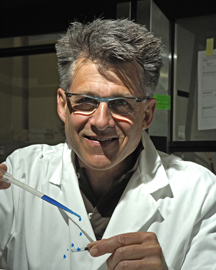
Researchers have been interested for at least 25 years in understanding interactions taking place underwater between materials, but stymied in their ability to observe, quantify, and explain them.
When flat water-hating surfaces approach each other underwater, scientists have observed that they snap into contact. This is due to attractive forces that extend for tens to hundreds of nanometers.
These distances are unexplainable by conventional theories, which find no naturally occurring local force strong enough to accomplish this task.
In a paper published Aug. 3 in the journal Nature, Sandia researchers were able to increase the distance from nanometers to microns of what may be the same interaction. The new conditions may help explain the unexpectedly long-range attractions of hydrophobic surfaces under water.
One change was this: Rather than using merely smooth hydrophobic surfaces, the materials were rough superhydrophobic surfaces on which water droplets roll like marbles.
Superhydrophobic surfaces can be formed simply from a silica solution by an evaporation-driven assembly process developed by Sandia Fellow Jeff Brinker (1002).
“Previous experimentalists had always used smooth materials — but most common materials are rough, and roughness greatly influences the interaction with water,” says Jeff.
The group’s observations indicated that two superhydrophobic surfaces approaching each other force the water between them to change state to a vapor, creating a cavity. This cavitation event is characterized by less internal pressure that may be the cause of a very long range attractive interaction and possibly of longer-scale version of the unexplained interactions seen to date for smooth surfaces.
In addition, a microscope that resists the “snap-together” effect enabled the Brinker group to measure the forces involved as the surfaces closed upon each other.
The microscope, called an Interfacial Force Microscope, was developed at Sandia under the direction of Jack Houston (1114).
Unlike the Atomic Force Microscope, the IFM actively resists “snapping” because of a kind of teeter-totter built into its observational tip. Through this resistance, the group slowed the “snap” into a longer time frame that allowed step-by-step observation of what exactly was happening in the formerly indecipherable moment.
“When force becomes overwhelming for an AFM, surfaces snap together uncontrollably,” says Jack. “The IFM just measures the force without caving in to it. We can move in as slowly as we want until we reach the point of contact.”
“There’s no other instrument that can do that,” says first author Seema Singh (1815), who did the experimental work under direction of Jack and Jeff.
“Seema Singh is a phenomenal experimentalist who really enabled all this stuff to happen,” says Jeff.
Although rough superhydrophobic surfaces have been of much recent interest for their self-cleaning properties (the so-called Lotus effect, where rolling drops of water cleanse such surfaces of particles and parasites), their interactions underwater have not been studied.
The superhydrophobic material was self-assembled by simply drying a slurry of hydrophobically modified silica in a technique originally developed to create super-low-density silica aerogels. During drying, the silica gel shrinks and re-expands to create a rough rather than smooth surface. The roughness creates a spike-like effect causing a water drop to adopt an almost spherical shape.
“This greater hydrophobicity apparently increased the distance over which cavitation could occur, allowing it to be visually imaged for the first time,” says Sandia researcher Frank van Swol, who calculated the theoretical cavitation distance and the energy and forces associated with cavitation.
The improved observation led the group to conclude that cavitation may be responsible in general for the hydrophobic interactions that exceed the known range of van der Waals forces.
The work was funded by Sandia’s Laboratory Directed Research Development (LDRD) office and then by DOE’s Office of Science, and the Air Force. The paper was authored by Seema, Jack, Frank, and Jeff.